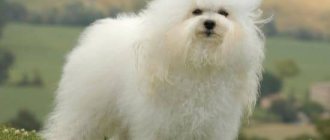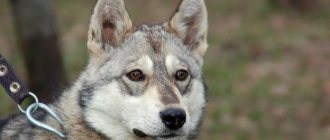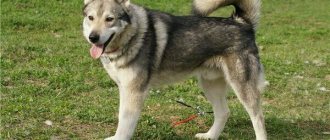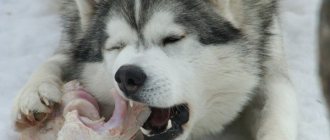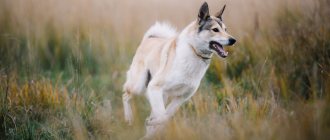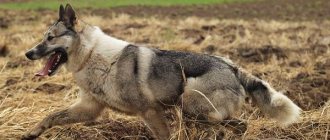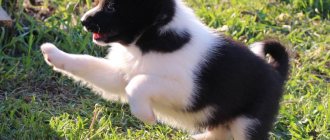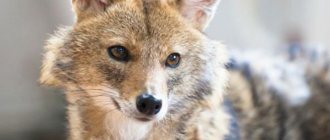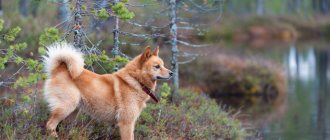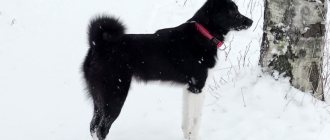Husky hunting is one of the most popular hunts among our hunters. Laika is an excellent hunting dog with a sensitive sense of smell, acute hearing and good eyesight. Laika is the beauty and pride of the domestic hunting dog breeding. Hunting with a husky can be carried out: for upland game (grouse, grouse, hazel grouse), for waterfowl (ducks), for fur-bearing animals (squirrel, marten, sable), for hares, for badgers, for ungulates (wild boar, elk, roe deer ), on large predators (bear, lynx). It is difficult to imagine a hunter in the vast expanses of Siberia and the Far East without his faithful assistant - the husky. Let's talk about hunting with huskies in more detail.
Working qualities of huskies
- Versatility
is one of the main qualities of a hunting husky. Laika can do anything. Like a hound dog, a husky can chase a hare or a fox, like a pointing dog, a husky can hunt broods of wood grouse, black grouse or hazel grouse. The hunting season with the husky can last almost all year round, starting with summer-autumn hunting for feathers, ending at the end of winter with hunting for large ungulates or bears. - Independence
is an important quality of a good working husky. Laika must know his job well, he does not need to be constantly tugged with loud commands, but such a dog’s work is a consequence of the hunter’s painstaking work in training and educating him. A good husky behaves on a hunt on par with the hunter, independently analyzing the situation and making decisions. The relationship between a husky and a hunter should be built on mutual trust. - Flair
is the most important quality of a good husky. Laika is capable of working with both upper and lower senses. Without a good instinct there can be no good husky. - Loyalty
, the husky has an independent character, but at the same time is extremely devoted to its owner. The husky's devotion is limitless; it is ready to give its life protecting its owner or members of his family. Laika has, among other things, excellent watchdog qualities.
Care and maintenance
Keeping it in a yard or a spacious enclosure is the best option for a representative of the breed.
They will be uninterested and completely joyless living in the same apartment with the owners. This is a skittish breed, prone to mood swings, so sometimes it needs to be alone. If you live with a husky in the house and keep it outside, do not forget to go out to spend time with it every day, it is better to do this several times. Also, do not ignore her natural need for walking.
Yes, a dog can relieve itself outside, but it also needs walks to gain new sensations. Don't deprive your pet of the opportunity to explore the world the way he wants. Give him freedom.
Laikas are not prone to self-indulgence or distracted behavior, so they will not run away if you let them off the leash. But, if there are other dogs nearby, it is better not to let the animal go, as it will certainly start a conflict with them.
What you definitely shouldn’t do is put a husky on a chain! This proud Siberian dog will not faithfully serve a man who will limit his freedom so much. Moreover, such a life will make the animal as unhappy as possible.
About care
The first thing you should pay attention to is the dog's fur. In huskies it is lush and straight, well protected from contamination
However, it is recommended to clean it once a year. Without this, the animal begins to smell unpleasant. Which shampoo to choose? You should buy a special detergent for your dog from a pet store. You cannot wash it with human hair shampoo.
Unfortunately, representatives of the breed often face such an unpleasant problem as tartar. It forms on the surface of his fangs. The best prevention is regular mouth cleaning.
Of course, your dog will not be able to brush his teeth on his own, no matter how smart he is. Therefore, he will need your help. In addition to regular oral brushing, give your pet soft bone cartilage regularly. This will help him get rid of tartar and plaque.
Ears are one of the most vulnerable places of a husky. They are often exposed to infections and parasites, especially if she regularly hunts in the forest. They should be inspected every week
You need to wash your ears regularly, but it is important to make sure that water does not flow into them!
Use a cotton cloth or cotton wool soaked in warm water to wipe their surface. It is also necessary to monitor the condition of your pet's eyes. They should not be sour or inflamed. Wash his face.
You should sharpen your dog's claws only if, for some reason, he does not do it on his own. Most active and nimble huskies do not need this procedure.
Hunting wild boar with a husky
Hunting for wild boar with huskies has always been popular among our hunters. Laika is a good companion on such a hunt. A husky trained to hunt a boar must have opposite qualities: on the one hand, it must be extremely vicious and courageous, on the other hand, it must be careful and deftly dodge the boar attacking it.
When hunting a wild boar, a hunter with two or three huskies moves through the land where the wild boars live, the huskies look for the boar's tracks. Having found wild boars by their tracks in a bedding or feeding area, they jump on them and begin to bark. The hunter, hearing the barking of huskies, begins to approach them. When a hunter approaches, the huskies angrily and recklessly attack the wild boars, thereby distracting their attention from the hunter.
Holding a large boar in place, smart huskies do not climb towards it from the front, but carefully grab it by the hind legs, while one husky barks at the boar in front and he focuses all his attention on her, preparing to attack her, while the other husky grabs him behind his back leg and immediately jumps away. A boar, bitten by a husky on the hind leg, turns around with lightning speed on the spot, sharply turns its snout towards it, trying to pry it with its fang, at this time another husky grabs it from behind. All this time, the huskies bark angrily at the boar. The boar is forced to press its butt against a stone, tree or stump. The boar is besieged in place. The hunter approaches the boar and shoots it in the ear or under the shoulder blade.
When approaching a boar, the hunter needs to be attentive and extremely careful; he must choose a position so that there is a tree nearby, behind which he could jump back if the shot is unsuccessful and the boar turns towards the hunter.
In many places in our country, when hunting wild boar, they use hounds and mongrel dogs, which have high viciousness and courage towards wild boars. These dogs are allowed to hunt wild boars in large flocks. But these dogs are not suitable for hunting wild boars; they attack the boar from the head, grab it with a death grip by the scruff of the neck, by the ear, and freeze. They can still cope with a gilt, but a large boar will invariably cut such a dog with its fang. A lot of dogs die on such a hunt, some from the inability to dodge the boar, the other part die in the crowd that they create around the boar. Such a hunt causes nothing but regret.
Laikas are often used in wild boar hunting to find wounded animals. The boar is a cunning and dangerous animal, especially if it is wounded. A wounded wild boar is dangerous for both humans and dogs; being cunning, it can set up an ambush, wait for its prey and suddenly attack when it is not expected. Laika is very useful in searching for wounded wild boar, which can travel hundreds of meters, especially if the hunt does not take place in winter and there is no snow on which the boar’s tracks and drops of blood from its wound are clearly visible.
Laikas are not specially trained to hunt wild boars; they acquire all skills directly during the hunting process. Laikas, like all dogs, have an innate dislike for pigs; you just need to take the dog hunting and it will immediately start working. Especially useful for a young, inexperienced husky is hunting together with a good, experienced husky. From a more experienced dog, a young husky will quickly understand the techniques of catching in place and caution in relation to the wild boar.
When hunting wild boar, huskies are often injured. To protect the dog, there are special vests that protect the dog’s stomach and sides from injury. A hunter with a husky must have a first aid kit with a minimum set of necessary medications. The first aid kit should contain: brilliant green or iodine for disinfection, a rubber tourniquet, bandages, a surgical needle and thread.
Health
East Siberian huskies are distinguished by good health. The average life expectancy is 10-12 years, but there have been cases of longevity. Many dogs, with proper care and proper exercise, can live 14-15 years, remaining in excellent working shape.
Diseases
Laikas are not susceptible to genetic pathologies. But they are characterized by diseases associated with hunting activities:
- Leptospirosis. While walking or while hunting, a dog can eat a mouse and become infected with this disease. Or be bitten by a marten or weasel, which can also cause infection.
- Esophageal worms. While hunting, the East Siberian husky can catch and swallow a small rodent suffering from this infection. And thus she becomes infected.
- Snake bites. The viper is the enemy of huskies. Often the dog strives to enter into a fight with a dangerous opponent. A snake bite to the neck area is especially dangerous. The owner must have anti-snake serum with him. This will help save your pet from death.
Vaccinations
A healthy dog is the owner's concern. Carrying out routine mandatory vaccinations will protect your pet from dangerous fatal diseases, one of which is rabies. Owners of huskies are advised not to miss vaccination dates, as the dog is especially susceptible to diseases when in contact with wild animals. Before vaccinations, a number of preparatory measures must be taken:
- Expulsion of worms. Almost all puppies are infected with worms. Two weeks before the expected vaccination, dogs are given anthelmintics.
- Flea and tick treatment.
- A visit to a veterinarian who will give an opinion on your health status.
Complex vaccines allow you to simultaneously vaccinate your dog against a number of diseases. The Nobivak vaccine has proven itself well. The veterinarian selects an individual immunization schedule.
The standard schedule is:
- The first vaccination is at the age of 8-10 weeks. The dog is vaccinated against diseases such as canine distemper, adenovirus infection, parvovirus, parainfluenza.
- After 2 weeks, revaccination is performed.
- The third is after a complete change of teeth, usually at 6 months. The same vaccine is administered as at 8-10 weeks, plus anti-rabies serum is added.
- The next vaccination is at the age of 12 months. All previous vaccinations are completed.
Moose hunting with a husky
Moose hunting with a husky begins when it reaches the age of one and a half to two years. A good option for training a husky for elk hunting is to put a young husky to work together with an experienced husky who knows how to work well on elk.
To hunt elk, the husky must have good physical shape, a strong heart and healthy lungs, since the elk has great power and endurance, the hunt for it can last a very long time, the husky will have to chase it for more than one kilometer, most often through dense thickets or deep snow.
A good elk husky should have a wide search. In order to find the trail of an elk, the husky must search widely and deeply, up to 1-1.5 km along the path of the hunter. Dogs with a short search are not good elk hunters.
When hunting elk, the husky can gallop or trot during the search and analysis of the trail, but when the trail is found, the husky must pursue the elk in a quarry. A racing elk walks at a speed of 20-25 km/h, a dog running at a trot or walk simply will not catch up with it.
The main task of a husky when hunting elk is to place the elk on the stand and hold it until the hunter approaches. Laika must: silently at a large gallop catch up with the moose, overtake him, come in front and bark at him from the head with moderate anger, diverting attention to himself, spinning and maneuvering to force him to stop and prevent him from moving forward.
The husky should not come too close to the elk’s head, much less rush at it angrily, otherwise the elk will either get away or, even worse, kill the husky with its front leg. The dog must have a special sense of distance in order to avoid being hit by the elk's front legs.
A husky that viciously works at an elk from behind, without overtaking or going in front, only drives the elk forward and cannot stop it, such a dog is not suitable for hunting elk.
Sometimes the husky has to restrain the elk for a long time until the hunter approaches, sometimes the elk breaks from the stop, then the husky must persistently pursue it and stop it again, and each subsequent stop of the elk becomes more and more difficult.
A good elk husky should have a clear, strong and informative voice, which should be clearly audible from a long distance in any weather, then the hunter will be able to secretly approach the elk within a confident shot.
Comments
- Anton 05/12/2015 at 23:21 If you want a faithful assistant on the hunt, then you can’t think of a better dog.
The truth is that everything is not easy here either. You need to deal with it and teach it from childhood, not everyone can handle it... Reply - Tsybulko Nikolay Alexandrovich 12/04/2015 at 13:10
Not bad!Answer
- Nikolay 01/19/2016 at 01:56
I chose a husky puppy to hunt fur-bearing animals. Before purchasing, I analyzed information from many sources. I chose her for her genetic predisposition to hunting fur-bearing and ungulate animals. Does anyone here have experience hunting moose? Please tell me.Answer
Add a comment
latest comments
Alexey: How can I order?...
Vladimir: The material is outdated and requires correction on two points: - described ...
Mikhail: Is it possible to make a module for Muscovite heels? How much will it cost …
Gennady: One person did something and everyone else should be responsible for it...
: If he opened fire within the city, then this is not a hunter, but a idiot...
Anatoly: In the requirements for documents for renewal, replace the psychologist with a psychologist...
YuryY: Having shot 1 can of gunpowder, Bars was very pleased with it, the factory weighed it...
Acorn: You understand so much...
: Vile degenerates! Bastard hunters, cowards, shoot yourself and that’s it...
Alexander: 35g, it’s simply impossible to stuff it into a pistol cartridge. People, for example...
Vladimtr: No, it’s not a typo, it says 35 g of Gunpowder per bullet weighing 7.45 g of gunpowder...
Evgeniy: It’s not clear. But for a state fee of 650 rubles, can I buy pheasant and...
Survey
Bear hunting with a husky
Bear hunting huskies are used to search for dens, to pick up wounded animals and to hunt walking bears.
Properly prepared huskies can be of undeniable benefit when searching for a bear’s den.
To search for a bear's den, the hunter goes to places where bears hibernate, leading a husky on a leash. It is best to do this on frosty days, when the bear lies tighter. The hunter inspects all the places where the bear could make a den for itself; the husky smells the scent of the den from a great distance and pulls the hunter in that direction. The husky is restrained, not allowed to go to the den, and not allowed to bark, so as not to disturb the bear. The hunter carefully approaches the den and inspects it, after which he and the husky leave the den.
When searching for a den, the hunter must be prepared for the fact that the bear may rise from the den and then the hunter will have to shoot it. It is best to search for a den together with a reliable friend.
Burling huskies must have certain qualities characteristic of this particular specialization, they must bark briefly at the bear, but not give a grip, they must have reduced viscosity, and when recalled, they must stop barking at the bear and return to the owner.
When hunting a bear in a den, using huskies to lift the animal is an unnecessary luxury, usually the husky-den is taken away after the den is discovered, and hunting in the den is subsequently carried out without huskies, because very often when hunting in a den there are cases of huskies dying from a bear or from being shot by huskies the hunter himself.
Nevertheless, sometimes huskies are still used to lift a bear from a den; for this, hunters, together with huskies, come to a previously scouted den, the hunters position themselves near the den and lower the huskies. The huskies begin to bark and wake up the bear in the den; sometimes hunters help the huskies wake up the bear by pushing a wooden pole into the den. After some time, sometimes after a few minutes, the bear wakes up and jumps out of the den, rushing at the dogs. Sometimes the bear just roars in the den, sticks his head out and tries to hit the dog with his paw, only then, enraged, jumps out and attacks the dogs. Hunters shoot at a jumping bear. In the case of a wounded animal, the husky is set on the trail of the wounded animal. It should be noted that in many regions of the country, bear hunting in a den is prohibited by hunting rules.
Bear hunting with husky is also carried out for rutting bears. The hunter walks with two or three huskies around the places where bears are found and lets the huskies in. Laikas find the bear's trail and follow the trail to find the animal itself. Having found the bear, the huskies overtake him and force him into place with their grips. Experienced bear cub huskies use their grips to spin the animal in place, rein it in and restrain it until the hunter approaches. The hunter hurries to the barking of the huskies and, approaching the bear, shoots at him.
Origin story
It has been precisely established that the ancestors of huskies are outsider wolves who left the pack and joined people. The homeland of huskies is considered to be Western Siberia, where wolves mixed with local hunting dogs.
In pre-revolutionary Russia, the descendants of wolves were actively used in hunting by the Khanty and Mansi peoples . Laikas became constant companions of Soviet hunters.
In the first years of Bolshevik rule, the state needed a large amount of furs in order to sell it abroad, receiving foreign currency in return. And the main suppliers of fur were Siberian hunters. Sables, martens, raccoons, and squirrels brought in foreign currency, so the authorities tried in every possible way to help the hunters. The help also touched our constant companions – huskies.
- In 1925, an official description of the breed was compiled and published, where the varieties were classified according to the ethnographic principle proposed by A.A. Shirinsky-Shikhmatov. The standards were created by fans of the breed, led by I. Vakhrushev. The description turned out to be confusing, but it allowed us to start working on breeding huskies.
- In the 1930s, a section of husky lovers was organized. It was headed by zoologist and geneticist S. Bogolyubsky. Subsequently, the section was chaired by famous dog handlers: I. Vatrushev, P. Pupyshen, A. Fedosov.
- In 1939, the All-Union Cynological Meeting was held, as a result of which temporary standards for five varieties of huskies were adopted and it was decided to begin breeding them.
The work on huskies was entrusted to the leading Soviet nursery “Krasnaya Zvezda”, but breeding was carried out in other nurseries - in the Moscow, Sverdlovsk, Novosibirsk and Perm regions.
The selection of breeding dogs in the Urals was carried out by dog handler N.B. Poluzadov. The ancestors of modern West Siberian Laikas were the males Dzhubar and Taezhny.
The Great Patriotic War did not prevent breeding work on huskies - the state’s need for currency became even greater: it was necessary to purchase equipment and products abroad.
In 1942, Zagotzhivsyrye and Tsentrosoyuz founded about 70 nurseries specializing in hunting dogs. Of these, 25 bred only huskies, and in another 27 huskies predominated. This attention allowed the breed to endure the hardships of war without problems.
Altair
I'm Altair, the site's mascot!
Ask a Question
In 1949, Soviet dog handler, author of books on dog breeding E.I. Shereshevsky put forward a proposal to change the classification: he believed that crossing of huskies occurs within individual regions. The proposal for a geographical classification was adopted in 1952.
New standards were drawn up and approved in 1954. There are four varieties left:
- Russian-Finnish huskies;
- Russian-European huskies;
- East Siberian Laikas;
- West Siberian huskies.
Aboriginal taiga huskies, German shepherds and dingoes left their mark in the gene pool of West Siberian huskies . Experts still divide West Siberian huskies into two types, which differ slightly in appearance:
- Khanty (for cold, harsh climates);
- Mansi (for dense taiga).
The West Siberian Laika reached its peak of popularity in the 1960s and 1970s. The dogs won shows, their versatility appealed to hunters all over the world. The International Canine Association officially recognized the West Siberian Laika in 1980. This is the most common type of husky.
Hunting a badger with a husky
Laikas are good helpers in badger hunting. Hunting with huskies for a badger is carried out at night on an animal that has emerged from its hole and is feeding.
The badger is nocturnal; during the day it sleeps in its hole, and at night, making sure that there are no enemies nearby, it goes out to feed at night. All night he wanders through the forest in search of food, moving quite far from his hole, and returns to his hole before dawn.
The husky should intercept him during his night feeding. The hunter lets the husky search near the badger's hole; it finds a fresh trail of the badger and along it the animal itself. Having found the badger, she barks at him and holds him in place with her grip. The hunter quickly goes to the place where the husky is barking, the presence of the owner encourages the dog and it presses on the badger, grabs it by the butt, spins it in place, preventing it from running away.
Laika is taken for badger hunting when it is at least one and a half years old. Laika must be strong, brave and angry. Before the hunt, it is advisable to introduce her to the badger at the baiting station.
A husky to hunt a badger must be vicious towards the animal; it must try to grab and kill the badger without letting go of its teeth. Laika should not be afraid of dense thickets, tree debris and wet places.
History of the breed and its psychological portrait
As you know, the West Siberian Laika was bred on the basis of 2 breeds. In the 20th century, cynologists from Russia created standards for huskies. Most likely, the formation of the breed would have been impossible if specialists had not selected animals for the best hunting qualities: endurance, speed, developed hearing, vision and scent.
The brave dog will become an excellent companion to the owner and an excellent hunter. The dog quite quickly becomes attached to the person who raises him. From loneliness, a dog whose color is very beautiful can get sick. Therefore, she needs to pay maximum attention.
The pet is kind and balanced. He is good with small children. However, the Siberian character makes itself felt. The dog can become aggressive when provoked for a long time. Very often, males have a desire to dominate among dogs.
As you know, the West Siberian Laika was bred on the basis of 2 breeds. In the 20th century, cynologists from Russia created standards for huskies
Having chosen this breed, you need to be prepared that huskies are very active, and you should work with them every day and teach them commands. This way, the dog will not accumulate excess energy.
Hunting with a husky for broods of upland game
At the end of summer - beginning of autumn, a hunter can successfully hunt with a husky for broods of upland game: wood grouse, black grouse and hazel grouse. At this time, broods of upland game are kept in berry patches. Hunting is carried out in the morning, while the dew has not yet subsided; at this time, the broods of broods are best visible in the dew. The husky is used to search for game, having detected the scent of a bird, the husky follows the scent and raises a brood, which scatters and settles in the nearest trees.
Laika runs up to the tree on which the bird is sitting and begins to bark at it. The hunter carefully approaches the barking bird and fires a shot.
During such a hunt, the husky should not go far; it should carefully search the area with a radius of 30 meters around the hunter. Having discovered a trace, the husky must slow down in order to understand the traces and obstacles. The husky should approach the bird listening, stealthily, and with a sharp jerk lift the bird onto its wing. After the bird takes off, the dog must determine the direction of its flight and immediately follow it to trace where the bird landed on the tree.
Young wood grouse and grouse have a strong odor that makes a young dog very hot. You only need to shoot the bird that the husky barked at; when the dog finds and brings the prey, you need to take the game from it, and be sure to praise the husky.
When hunting for broods of upland game, it should be taken into account that in the morning you should look for them in feeding areas, in berry fields, in the afternoon on flutters and swimsuits, and in the very heat in shady places.
Choosing a pet
Before you start looking for a puppy, you should determine why you need a dog. Do you need a hunter or a good companion? If you decide that you need a hunting dog, then puppies should be purchased from the best breed of Laikas. The puppy's parents must have the following breed characteristics:
- oblique eyelid incision;
- erect ears;
- Brown eyes;
- sharp muzzle with dark nose;
- fluffy tail;
- soft undercoat;
- The spine is straight and hard.
A very good sign in the ZSL is the presence of a tail, which is wrapped in a ring.
The pet is kind and balanced.
It must be remembered that an animal of this breed develops very quickly. That is why it is better to buy a dog at the age of 4 weeks. One should already have ears in the shape of a triangle, a gentle transition from the forehead to the muzzle, and there should be no folds on the lips.
Hunting with a husky for wood grouse in aspen forests
In autumn, wood grouse prefer to feed in the morning and evening on withered aspen leaves, after they have been slightly frozen. Sometimes they stay in such places for the whole day and even spend the night. A hunter with a husky on a leash quietly walks around such aspen forests. Wood grouse, while feeding, make a lot of noise, fiddling among twigs and branches and tearing leaves from trees. The hunter hears such a noise from afar, the husky hears it from an even greater distance and begins to show signs of impatience. The hunter lets the husky off the leash, the husky discovers the capercaillie and begins to bark at them. The hunter slowly and carefully approaches the husky's voice, trying to hide behind some cover and pausing during the husky's silences. Having approached shooting distance, they look out for the capercaillie and fire a shot. If, upon approaching a wood grouse, the hunter cannot immediately detect it, you need to stand quietly, without moving, for some time, until the wood grouse moves on the tree, thereby giving away its presence.
After the shot, you do not need to immediately pick up the downed capercaillie; you need to let the rest of the capercaillie calm down and continue the interrupted feeding. The Laika begins to bark at the next bird, the hunter continues his hunt.
After the end of the autumn hunt for wood grouse in aspen forests, the hunt for wood grouse with husky continues throughout the autumn until deep snow falls. Laika also barks at capercaillie sitting in the trees, although it becomes much more difficult for the hunter to unnoticed to approach the capercaillie within shooting distance.
Standard Features
average height, strong constitution and muscles
The characteristic shape of the head is triangular with equal hips. They traditionally have a wide skull and a long muzzle. This image is complemented by almond-shaped or oval brown eyes. The ears are usually triangular in shape and erect.
The chest has developed muscles, the stomach is tucked. The legs are quite powerful, the tail is crescent-shaped.
When you first meet the West Siberian Laika, you will be struck by its short fur. The undercoat has a thick layer; in the neck area it is very dense and forms a collar. In accordance with the standard, it is customary to distinguish several types of husky colors:
- grey-white;
- grey-red;
- piebald;
- pale yellow.
Sometimes there are black and white animals, but such animals are not very popular.
Hunting with a husky for hazel grouse
Hunting with a husky for hazel grouse is in many ways similar to hunting for other upland birds; it begins in early August. The peculiarity of the hazel grouse is that it cannot withstand the loud barking of a husky and flies off before the hunter approaches. The hazel grouse will sit calmly on the tree, only when the husky does not bark loudly, but only whines and squeals, then the hunter calmly approaches, looks out for the hazel grouse and fires a shot.
It can be quite difficult to see a hazel grouse hiding in a tree, due to the protective coloring of its plumage. Some hunters, in order not to look for a hazel grouse in a tree, stand in a place convenient for shooting, near the tree where the hazel grouse is sitting, scare it away and shoot it in flight. A frightened hazel grouse does not fly far, most often it flies in a straight line, the husky runs after it, and when it sits on a tree, it indicates the place of its landing.
It is not difficult to train a husky over a hazel grouse so that it can work on it without loud barking. To do this, from the very beginning of the training, you should not allow the dog to bark at them, and after the brood of hazel grouse has risen, you need to take the dog on a leash and command it in a whisper “no, no.” You need to repeat this technique several times until the husky understands what is required of it. When the husky understands that she cannot bark at the hazel grouse, her hunting passion at the sight of game will make her whine and squeal with impatience, which is what the hunter needed to achieve.
Bear
You can start training a husky for a bear, as for any other large animal, right on the hunt. Please note that when hunting, the dog must be able to find a den, a wounded animal by following a bloody trail, and catch up with a leaving predator, stopping it with its grip. And having stopped, we bark to indicate to the hunter where to move.
Ideally, training should begin with getting to know the animal that has just been killed. Then you can go to the tied bear. It is better to start training with an 80 kg individual, which should be agile and mobile, able to fend for itself when attacked by annoying dogs.
To train, stretch a cable in a clearing between trees up to 50 meters long. Restrictors should be placed on it so that the bear cannot climb the tree. The bear is transferred to the training rope from the walking rope. The dogs must be in a place from which they cannot see this moment. Put the young dog on the trail by introducing him to it. First, walk along it on a leash for about 50 meters, and then let her down so that she can find the bear herself.
During the first training, it is allowed for the owner to be nearby, by his presence creating conditions that can prevent the dog from being frightened. In the future, you need to be on the sidelines so that the likes can be processed independently.
It is recommended to go on a real hunt not with one, but with several likes that have already worked well with each other.
Squirrel hunting with a husky
The husky's squirrel hunting is a hereditary trait by which the best huskies have been selected for hundreds of years. The Laika is the only breed of hunting dog that can hunt squirrels. Old experienced wolf hunters believe that every husky hunter must have a squirrel diploma, regardless of what her main hunting specialty is.
When hunting a squirrel, the husky must carefully search those places of the hunting grounds where squirrels prefer to stay, straight across clearings and black forests where squirrels do not exist. Having discovered the trail of a squirrel, the husky must reach a tree, check for the presence of a squirrel on it and give a voice, calling the hunter. With its barking, the husky indicates to the hunter the tree on which the animal is hiding. If a squirrel breaks away and rushes along the branches of trees, the husky should chase it along the ground until it stops and hides in some tree.
The squirrel knows how to skillfully camouflage itself; its winter fur helps it a lot in this. The squirrel presses against the trunk, lying motionless on it and completely merging the color of its fur with the bark of the spruce tree. The most difficult thing for a hunter is to spot a squirrel hiding in a tree. Even an experienced hunter does not succeed immediately; the hunter spends a lot of time until he has the opportunity to fire a shot.
Buy | sell
| I'll give it to good hands Moscow April 18, 2020 Domestic mixed-breed puppies, 2 months old, g/w, different colors, will grow to be of medium size, very affectionate, cheerful and sociable, waiting for a reliable… |
| I'll give it to good handsMoscowApril 5, 2020 Cheerful Butch is looking for a home! Age: 3.5 years. Weight: 34 kg. Height: 65 cm at the withers. Healthy, vaccinated, neutered. Temperament/character: choleric and extrovert. ... |
| I'll give it to good hands Moscow March 29, 2020 Beautiful mixed-breed husky puppies, 2 months old, very smart, domestic, different colors: gray, black, black and white. Very good dogs for a family with… |
| 10 Belgorod8 February 2019 West Siberian Laika puppies, born 12/21/19, two boys and two girls |
| 5000 NovosibirskOctober 11, 2018 Selling West Siberian Laechkas. Purebred. Parents are workers. D. r. 09/04/2022. |
| 5000 Krasnodar25 April 2018 Laika puppies, born on March 13th. 1 boy left -5000?, and 3 girls -3000? . Parents with a passport. Mom is pure white. I'll give in!!! |
| 40000 January 17, 2018 I am selling a male West Siberian Laika, date of birth November 17, 2016, origin (Zyar VPKOS No. 1987/11 - Umka St No. 391-1631/LZS) Male with character, ... |
| I'll give it to good handsMoscowDecember 10, 2017 Our dear Linda looks a little like a cute fox with a neat face and house-like ears. Linda is a West Siberian Laika mix. Very devoted... |
| I'll give it to good hands Moscow November 25, 2017 We present to your attention a West Siberian husky mixed breed named Chuk. Our Chuk looks like both his mother Laika and a real gray wolf. Special charm... |
| 12000 September 18, 2017 West Siberian Laika puppies with pedigree for sale. There are 4 males and 1 female in the litter. Parents at field tests have diplomas in bear, badger, ... |
| Norilsk27 August 2017 Husky puppies for sale. The West Siberian Laika is a Russian breed of universal hunting dog. A dog of average and above average height, strong, dry... |
| 13000 May 20, 2017 West Siberian Laika puppies for sale from working studs with a pedigree. Born on April 18, 2022. There are 3 males in the litter. and 3 females. Father is a worker... |
| I'll give 100 to good handsMoscowApril 5, 2017 I will give into caring and loving hands a very active, intelligent, kind and affectionate girl, a West Siberian husky mix. Age 5 months. Bonya has been processed... |
| 20000 Murmansk February 27, 2017 I will sell puppies with a pedigree (stamp and metric of the puppy). Born January 13, 2022. Working parents (confirmed by diplomas). Call for details. |
| 12000 Krasnoyarsk February 6, 2017 West Siberian Laika puppies for sale. The parents are of high breed, have EXCELLENT exterior grades, diplomas in bear, boar, badger, and squirrel. ... |
| 15000 ShaturaDecember 20, 2016 1. Breed: ZSL 2. Number of puppies (males/females): 2/2 3. Date of birth of puppies: October 23, 2016 4. Color: male No. 1: gray-red with white male No. 2:… |
| 1000 mating Podolsk November 8, 2016 Male ZSL for mating in Podolsk, Moscow region. From working parents. Works properly on squirrels. We can take two or three puppies. |
| matingBryanskOctober 24, 2016 Male Trans-Siberian Laika, with pedigree, age 2 years. |
| 12000 October 13, 2016 Laika puppies for sale. Breed: West Siberian Laika Number of puppies in the litter (males/females): 3/3 Date of birth of puppies: September 6, 2016 Color:… |
| 10000 September 12, 2016 I will sell West Siberian Laika puppies from working parents. Date of birth 08/22/2016 Parents are commercial hunting dogs, they work in the taiga fur... |
| Istra12 July 2016 wonderful puppies with excellent pedigree from real hunters. boys and girls. Inexpensive. Born May 30, 2016 |
| 5000 Novomoskovsk16 May 2016 Zapodnosiberian Laika puppies mom and dad with documents |
| 10000 KrasnoyarskMay 2, 2016 I will sell LZS puppies from working fur dogs. The puppies were born on March 25th. There are 2 males and 2 females in the litter. |
| I'll give it to good hands Kazan April 19, 2016 We will give a West Siberian husky puppy to our home. she is 1.5 months old, very cute. . . . . it's hard for her in the apartment |
| 10000 Krasnoyarsk April 7, 2016 I will sell Laika puppies from working, purebred Laikas. Puppies were born on February 20, 2016. Parents in the taiga work on sable, elk, badger and wood grouse. For sale… |
| 4500 Ryazan April 3, 2016 Selling puppies from working parents. bargaining is appropriate |
| 20000 Lyubertsy2 March 2016 5 puppies for sale, gray red color. Distribution of puppies, February 19. Father of the puppies p.ch. Grip line p.p.p.p. Zuban Vronsky A.Yu. bitch then male p.p. Vagaya… |
| matingKirovFebruary 25, 2016 We offer West Siberian Laika, male, 3 years old. Thoroughbred, with documents. |
| 1000 February 10, 2016 I sell West Siberian Laika puppies, born November 10, 2015. Parents are workers (ungulates, fur). Two bitches left. 8 (960) 545-98-11(Margarita) |
| matingSochiJanuary 27, 2016 |
Hunting with a husky for marten and sable
Most huskies trained to hunt squirrels immediately begin working on martens and sables. You can speed up the training of a husky on these animals if you let it work together with a well-working, experienced husky.
A husky, having stumbled upon a fresh trail of a marten, will immediately follow it, but since the marten often likes to ride on horseback, the husky will lose the trail in such a place. The hunter must help his husky straighten the trail and must himself examine places where the marten can arrange a place for the day. The marten, raised from its rest, quickly rides away from the husky, leading the dogs to a long distance. Such a pursuit can last 2-3 kilometers until the marten stops on a tree, from which it cannot jump from to another, then it hides on it, and the husky barks at it. The hunter must rush to the husky, spot the marten and fire a shot.
It happens that a marten hides in a hollow, then in order to get it out of there, they either take the marten out with a gloved hand, or cut a hole below the hollow and drive the marten out with a twig.
Hunting a sable with a husky is similar to hunting a marten, the difference is that the sable most often does not go on horseback, but on the ground, trying to hide in the rubble of trees or dense bushes. Laika detects it and begins to bark; when the hunter approaches, the sable often tries to immediately leave, so the hunter needs to be ready to shoot.
Dog care
Despite the fact that likes do not require special care, important points must be taken into account in their maintenance. You need to know that the health and well-being of these breeds largely depends on physical activity and being in the fresh air. Therefore, the best option for keeping it is the countryside. If you live in an apartment, then you need to regularly walk your dog for 2-3 hours a day.
You also need to take into account that the West Siberian breed has thick hair that needs to be combed regularly. It is recommended to feed the dog 2 times a day, mainly with food of animal origin, with the obligatory addition of specialized vitamins and minerals.
Duck hunting with a husky
The Laika, as a universal hunting dog, can be used by a hunter, including for duck hunting. The Laika, according to its natural characteristics, is well suited for hunting waterfowl; some hunters even believe that the Laika copes with duck hunting better than the spaniel.
The search for a husky when hunting ducks should not be wide and not deep, always close to the hunter, within the range of a rifle shot, otherwise the whole point of the dog’s work is lost. An experienced husky, who knows how to work on ducks, narrows the search to the required breadth. The complexity of the wetlands itself reduces the search for huskies. If the husky searches too broadly and moves too far from the hunter, you need to shorten the search, calling the husky closer to you.
The chasing of ducks and the wide search must be reduced by calling the husky closer to you.
When approaching a pond, the husky should not immediately climb into the thickets, scattering the ducks in all directions, but should first wait for the owner to approach and only then go in search. It is better to bring a young husky to a pond on a leash.
A good husky should be able to use its senses well, both upper and lower, it should be able to use the direction of the wind when searching for game, and also be able to make out the smells left by ducks on plants.
Duck hunting is associated with long-term work of the dog in the water, in reed thickets; all this places increased demands on the husky’s physical form and its persistence in work. A dog that does not want to work in the water, often crawls out onto the shore, and does not want to thoroughly search places overgrown with reeds, where ducks most often hide, is not suitable for such a hunt.
An important part of the husky’s work when hunting ducks is the delivery of downed game; the husky must perform this work flawlessly both from water and from land, from dense thickets. A high-quality delivery of downed game by a husky is the result of the dog’s upbringing and training by a hunter.
Some huskies perfectly carry downed game from the water and reeds, but are very reluctant to carry the game overland and do not give it into the hands of the hunter, but place it, at best, on the first dry hummock, at worst, on the bank opposite from the hunter, if it happens to be closer to husky than the one on which the hunter is located. This behavior of the husky means that it has not been trained in the correct presentation. If a young husky, having found and taken a duck, hesitates in returning to the hunter, it is called to itself using the command “give it” or “come to me.” The husky should not be allowed to strangle wounded animals, scuffle or crush game, all this can ruin the husky.
In addition to running duck hunting, the husky can be used for hunting duck flights. The main job of the husky on such hunts is to retrieve downed ducks from the water, search for ducks in reed thickets, search for and retrieve wounded animals. When hunting on flights, the hunter, by the behavior of the husky, knows in advance the direction from which the ducks will fly. Such assistance from a husky is especially useful when hunting in conditions of limited visibility, at morning and evening dawns.
Laika sits down on the command “sit”, in a place where it is clearly visible to the hunter. Hearing the whistling of the wings of flying ducks, the husky pricks up its ears and turns its head in the direction from which the ducks are flying. The hunter, warned by the husky, turns towards the attack of ducks and prepares to shoot. When the ducks approach, the hunter fires a shot and, if the shot is successful, sends a husky to retrieve the downed duck.
Basics of training
Training a puppy must begin from the first hours of its presence in your home. If you choose a dog for yourself exclusively as a friend, and not a hunting companion, then it is enough to teach it the basic commands and make sure that it carries them out unquestioningly. First of all, during the game, teach your pet its name.
Then he must master the collar and later the leash. The first command that the husky understands is: “Near!” Over time, teach her to respond to the owner’s voice, the sound of a whistle, and follow the commands “Lie down!” and “Sit!”, bring the desired item. Laikas are also taught to swim in bodies of water through play; the dog cannot be forced into the water.
Laikas should be trained outdoors, ideally in the forest. The dog should definitely be encouraged, but not too flirted with it.
Hunting with a husky for a hare
The Laika is rightfully considered the most versatile hunting dog, so if desired, a hunter can train his dog to hunt a hare. Old husky owners still believe that chasing hares with huskies is unacceptable; they consider the husky as an exclusively fur-bearing dog, and hunting a hare with a husky is empty pampering that only spoils the dog.
Hare hunting and duck hunting are two of the most beloved and popular among Russian hunters, so if the owner of a husky wants to hunt a hare with it, this is his personal choice.
Most huskies have a valuable quality - not to give a voice on the trail of an animal. The husky should not bark at the tracks of birds, large animals or small fur-bearing animals; in all these cases, the husky is required to be careful and silent. Laika starts barking at the animal only when she sees it. The same applies to hunting a hare with a husky; the husky begins to bark at the hare only when it sees it or in close proximity to it, on the hot trail.
When training a husky on a hare, you need to show it the places where you need to look for hares; to do this, you need to climb thickets of bushes and other favorite roosting places for hares together with the dog; in the future, she herself will carefully search the support, skipping obviously empty places on a straight line. Laikas remember well the places where they picked up the hare and will definitely check this place carefully next time.
Laika, unlike a hound, is not so tough that it can chase a hare in several circles; most often it chases until the first chip, since it does not have the necessary experience to figure out on its own the intricacies of a hare's tracks. Having chipped, the husky returns to its owner. In this case, the hunter must help the husky find the trail; to do this, you need to return to the place where it lost the trail and make several circles with it, encouraging the husky with the command “look, look.” With each hare caught, the husky’s toughness and skill will increase and she will be able to figure out the hare’s complex trail herself.
Description of the breed
Laikas have a well-developed skeleton and overall physique. They are of medium size and have an average constitution. The height of adult males can reach 62 cm, but the height of females, as a rule, does not exceed 55 cm. The elongation index for this breed for males ranges from 103-107, and for females 104-108. The head of the animal is wedge-shaped, and the muzzle is elongated and slightly widened in the area of the fangs.
The key features of the breed include:
- The tail should be bent upward in the shape of a sickle or curled into a ring, and be sure to touch the back of the animal.
- The ears should resemble 2 elongated triangles in appearance and be erect.
- Regardless of the specific breed, all huskies must have brown eyes.
Hunting with a husky for lynx and other cats
The lynx is a rather rare animal, which is found in dense, dark, dense forests with tree debris and windbreaks, which are rarely visited by people. There are cases when lynxes appear in forests near cities. Lynx hunt at night, the main prey of the lynx are hares, at night the lynx makes long journeys, tens of kilometers long.
Any husky is suitable for lynx hunting; there is no need to do any special baiting for lynx, a husky has a natural malice towards cats and if placed on a lynx's trail, it will happily go after it. It is best to hunt lynx with two or three strong, large, bold and angry huskies.
A hunter with a husky walks around the grounds in search of a fresh lynx track; when a track of a lynx returning from a night hunt to the bed is found, dogs are released along the track. The lynx flees, realizing that the huskies will soon overtake it, the lynx climbs a tree and hides, hoping that they will not notice it and that it will follow its own trail back to its bed. The huskies discover the tree on which the lynx is hiding, and sometimes the lynx itself, and begin to bark at it. The lynx must be shot in such a way that there is no wound, otherwise the wounded lynx will cripple the dogs.
In addition to hunting lynx, they hunt wild forest cats with huskies in the forests of the Caucasus and the Far East. The huskies quickly find them following a fresh trail, drive them up a tree and bark angrily. You need to shoot wild cats carefully so that there are no wounded cats; it is better to go up to bark, and before shooting, take your husky on a leash so as not to risk the life and health of your husky.
For the safety of your dog, you should not hunt steppe and jungle cats with your husky. When overtaken by a husky, they desperately resist and can maim the dog, and if a chance encounter with a wild cat does occur, you need to rush to the scene of the fight to help your dog.
Features of feeding and diet
Representatives of this breed usually require little food, but they are sometimes found to be food lovers.
The metabolism of huskies is slightly different from other dogs. Like all northern dogs, they need a protein-fat type of nutrition, while other breeds are characterized by a protein-carbohydrate diet. Laikas easily digest protein-rich and even fatty meats without putting much strain on the liver. If you create the right diet for such a pet, it will always look good and delight its owners with its activity. First of all, you need to decide on the type of food; dogs can be fed with commercial ready-made food or natural food. Ready-made diets are very convenient; you don’t need to waste time buying ingredients and cooking, but it’s worth noting that the dog can quickly get bored with this type of food and refuse it.
The metabolism of puppies is usually adapted to the mother's diet, so it is worth checking with the breeder what food your pet's mother was fed.
With a natural diet, you should develop a diet taking into account the weight, age, activity and health status of the dog.
The following foods should be present in the husky's diet:
- Meat - 60-70% of the entire menu, beef is perfect. It can be raw or boiled, depending on your dog’s preferences. The meat should be cut into medium pieces; minced meat should not be given - it will lead to indigestion.
- Sea fish - alternates with meat. Before feeding, you need to boil it and remove all the bones from it.
- Boiled vegetables - 20-30% of the diet. Vegetables you should choose: broccoli, pumpkin, cabbage (cauliflower and white cabbage), green beans, zucchini, turnips, carrots.
- Cereals - no more than 10−20%. It is convenient to give them in the form of flakes, after filling them with hot water. Among the cereals, it is useful for dogs to consume buckwheat, millet and rice.
- Dairy products. They replace one of the feedings, best done in the morning. Yoghurts without dyes and additives, low-fat cottage cheese and kefir are good for dogs.
When feeding huskies, it is worth considering the animal’s load. If the dog spent the whole day lying down, then it is worth reducing its daily portion by about a third.
Features of the breed, what distinguishes it from other breeds
Among the main characteristics of the breed are a strong character, passion for play, and dynamism, which are combined with balanced behavior. The appearance of the husky reflects strength and power, which are not inherent in small breed dogs.
It is impossible not to note the ease of care and nutrition. Some animals have fur that constantly mats, even with regular brushing. Some dogs experience problems with food and lack of appetite, which cannot be said about the Russian-European Laika.
Character and intelligence
The character of the Russian-European Laika requires a powerful and emotionally strong owner next to it. The dog is very persistent and quite vicious towards wild animals. When it sees prey, it can bark at the animal for a long time and approaches carefully. With proper upbringing, she extremely rarely shows aggression towards people. This dog has a very well expressed territorial instinct.
Therefore, a husky can only follow a dog with which a certain connection has been established. The husky also strongly protects its territory and does not allow strangers into it. She is very smart, but to fully demonstrate her abilities, she needs to go out hunting, assess the situation and make the logically correct decision. In urban environments, she can run away and get lost.
Dog behavior
A dog may start barking loudly when its owners are away. By barking, the dog informs its owner about approaching danger or the discovery of prey. This can become a problem if you do not live in a private home. Laika is quite balanced in behavior, but when other animals appear, it can begin to behave aggressively, showing its territory and its superiority.
Attitude towards children and others
Laika does not like small children because she demands respect, and at an early age a person does not always understand what can be done and what cannot be done. She treats older children better, loves to play and spend time with him.
Laika becomes strongly attached to its owner if he pays her due attention and is actively involved in her upbringing. The dog chooses only one owner; it loves and respects the rest of the family, but does not treat it as devotedly as it does to its main owner.
If properly raised, a Laika will never swear at others who do not violate the space of its owner. Since huskies strongly defend their territory, the entry of strangers and animals into it can cause spontaneous aggression. But the owner’s word will correct this situation.
Training and education
The Russian-European Laika is quite difficult to train due to its love of freedom and constant desire to run away somewhere. Only hunting allows a dog to fully realize its potential and demonstrate its mental abilities.
As soon as a husky appears in the house, from the first days it must be taught to behave correctly and follow commands. The dog must be shown who is boss in the house.
Important! You should not physically punish your dog, since it should feel protected in its home.
It is also necessary to pay special attention to the dog’s socialization and communication with other animals, since going out hunting can scare the dog away. If it develops on its own, then it will soon cause its owner a lot of inconvenience, from barking for no reason to complete disobedience.
For the full development of instincts, it is necessary to regularly spend time with the dog in nature. To train a dog to hunt, you must either entrust this to an experienced person, or consult with him and work with the animal yourself.

